The Highland Park Historic District is located on the southeast side of Mount Pisgah; it extends approximately three blocks northeast along Park Avenue from its intersection with Old Military Road. It was an expensive enclave, home to a number of millionaires, doctors, and other wealthy families, nearly all with one or more members suffering from tuberculosis. Residents included Thomas Bailey Aldrich, editor of the Atlantic Monthly, Dr. Lawrason Brown, director of the Trudeau Sanatorium, and Christy Mathewson, a major league baseball player. Homes here had extensive views south and east across the Saranac River to Mount Baker. The seventeen buildings within the district are private, single-family homes built between 1896 and 1930, with the majority built between 1901 and 1910. Almost all were used at one time or another as private cure cottages.
The land was originally the center of Ensine Miller's eighty acre hop farm. The Old Military Road, part of the old Northwest Bay Road from Westport to Hopkinton, crosses the property. In 1858, Miller bought the land from abolitionist Gerrit Smith, and farmed it until his death in 1877. Two years later, Orlando Blood acquired the property, and in 1891, sold it to Dr. Edward L. Trudeau for his sanatorium; the land was more than Trudeau needed, and he sold the excess to Dr. Ezra S. McClellan, who began to develop the area by 1898, selling parcels with deed restrictions designed to ensure that only expensive residential structures would be built, not commercial cure cottages.
From the NRHP nomination form.
| Residence | Old Address | New Address | Notes |

Katherine McClellan Studio, c. 1896 |
16 Old Military Road | 57 Old Military Road | Katherine Elizabeth McClellan was a pioneer woman photographer who began her career in the Adirondacks. She was the subject of a story in the Adirondack Daily Enterprise on September 19, 1945 that carried the headline Saranac Girl Hid Bodies of 10 Men Sent by Stranger. |
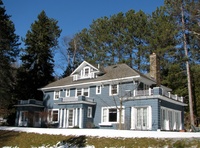 Christy Mathewson Cottage, 1924 Christy Mathewson Cottage, 1924 |
21 Old Military Road | 281 Park Avenue | A Colonial Revival-style house. Christy Mathewson was one of the greatest baseball pitchers of all time, winning thirty or more games in the regular season four times, throwing three shutouts over a period of six days against Philadelphia during the 1905 world series. He contracted tuberculosis, and came to Saranac Lake for the cure. |
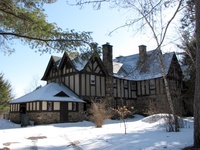 Dr. and Mrs. Joseph Nichols Cottage, Highland Manor, c.1910 Dr. and Mrs. Joseph Nichols Cottage, Highland Manor, c.1910 |
127 Park Avenue | 286 Park Avenue | A Tudor Revival-style house, it was the second house built in Highland Park. When built, the house and grounds had sweeping views from east to southwest. The property was known for its gardens. Dr. Joseph Nichols was the president of the Saranac Lake General Hospital. For 46 years after his death, his wife, Mary Morgan Nichols continued the tradition of hospitality at Highland Manor that he had started. |
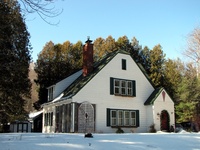 Hoctor Cottage, c.1930 Hoctor Cottage, c.1930 |
134 Park Avenue | 299 Park Avenue |
A two story, wood frame residence sheathed with wide clapboard and covered by an asphalt Shingled crossed gable roof. Fenestration is regular and symmetrical with grouped sets of six-over-one sash windows. An inset sitting-out porch on the first floor retains its original arched lattice screen on street side. |
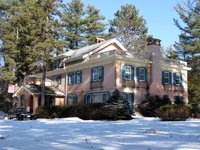 Charles M. Palmer House, the Pink Palace, built c.1902; altered 1927 Charles M. Palmer House, the Pink Palace, built c.1902; altered 1927 |
135 Park Avenue | 308 Park Avenue | A Mediterranean Revival-style residence designed by William H. Scopes and altered in 1927 by William G. Distin, Branch and Callanan, contractors. Charles M. Palmer was a wealthy newspaper broker from St. Louis. The Palmers were eccentric: their cats slept on pure silk sheets in a room with mouse-patterned wallpaper, and at mealtime, the cats sat on high chairs with linen napkins held neatly in napkin rings. |
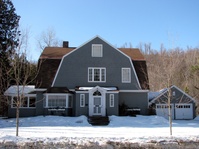 Jordan Cottage, 1905 Jordan Cottage, 1905 |
138 Park Avenue | 317 Park Avenue |
A two and one-half story, three-by-two bay, wood frame, Shingle style residence designed by Scopes and Feustmann. The dwelling is clad in wood shingles with intersecting asphalt-shingled gambrel roofs. Fenestration is symmetrical and includes grouped, multiple-paned sash and casement windows, Palladian windows in the side and rear gable ends, bay windows, and a semi-circular fanlight in the pedimented entrance porch. The original cure porches have been removed. A separate, contributing, single stall, ca.1900 garage with hinged doors is located at the rear of the lot. |
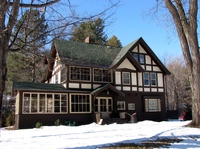 Dr. Lawrason Brown Cottage, 1902 Dr. Lawrason Brown Cottage, 1902 |
142 Park Avenue | 333 Park Avenue | A Tudor Revival-style house designed by William L. Coulter. Dr. Lawrason Brown was the Resident Physician at the Adirondack Cottage Sanitarium and an internationally known specialist in tuberculosis. He started the Journal of the Outdoor Life and helped to inaugurate the Trudeau School of Tuberculosis in 1916. |
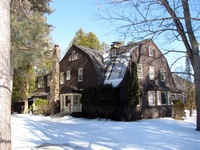 George V.W. Duryee Cottage, 1898 George V.W. Duryee Cottage, 1898 |
143 Park Avenue | 334 Park Avenue | A Shingle style house designed by William L. Coulter, built by Branch and Callanan, renovated in 1927 in a design by William G. Distin. George Van Wagenen Duryee was a real estate broker from New York City who came to Saranac Lake for his health in 1892; he bought the first lot sold in Highland Park. |
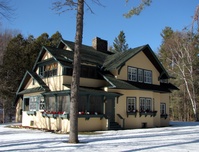 Ellwood Wilson Cottage, 1904 Ellwood Wilson Cottage, 1904 |
146 Park Avenue | 347 Park Avenue |
A two story, two by three bay, wood frame, Arts and Crafts or American Craftsman-style residence, built for Ellwood Wilson, and designed by Maurice Feustmann to resemble a Swiss chalet; the Wilsons had been in Davos, Switzerland, for the two years prior to moving to Saranac Lake. A later resident was judge Irving Edelberg, a highly decorated World War II veteran. The dwelling is clad in stucco with an asphalt shingled gable roof and central cross gable. The building features projecting eaves with smaller gable roofs below to shelter porches and doors, eyebrow dormers, grouped multiple-paned casement windows, a shallow bay window in a two-story central projection, and cure porches on both first and second floors. |
 Thomas Bailey Aldrich Cottage, "The Porcupine," c.1902 Thomas Bailey Aldrich Cottage, "The Porcupine," c.1902 |
147 Park Avenue | 350 Park Avenue |
A two and one-half story, six by three bay, wood frame, Shingle style residence designed by William L. Coulter, and constructed in 1902 for Thomas Bailey Aldrich, editor of the Atlantic Monthly, whose son, Charles, had tuberculosis, and died of it, age 34.. The residence is clad in wood shingles and covered by asphalt-shingled intersecting gambrel roofs. The residence features numerous dormers. Fenestration is regular with bay windows, grouped multiple-paned windows in a variety of sizes, with a two-over-two sash predominating, and glazed cure porches on both first and second floors. A two-car garage and carport were added to the house in 1962-65. |
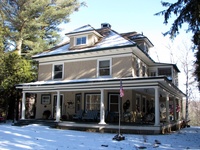 Talbot Aldrich/Page Watson Cottage, 1902-8 Talbot Aldrich/Page Watson Cottage, 1902-8 |
153 Park Avenue | 370 Park Avenue |
A two and one-half story, two bay square, wood frame, Colonial Revival style residence built between 1902 and 1908, with hipped asphalt shingled roof, deep eaves and full cornice, central dormers, and a wide veranda on west and south with a second story cure porch on the southern facade. Fenestration is regular and symmetrical with one-over-one sash. |
 Henderson Cottage, c.1907 Henderson Cottage, c.1907 |
154 Park Avenue | 371 Park Avenue |
The Henderson Cottage is a two and one-half story, three by two bay, wood frame, Colonial Revival-style house built for Charles R. Henderson, who founded the Saranac Lake Society for the Control of Tuberculosis and of the Saranac Lake Boys' Club. It is clad in narrow clapboards with asphalt-shingled hipped roof. A central entrance portico features columns supporting a pediment, a doorway with semi-circular fanlight, narrow sidelights, and open tracery in the upper portion of the door itself. The central block of the dwelling is flanked by two-story side wings with double cure porches. |
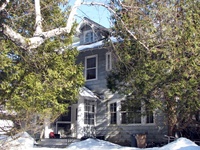 Roosevelt D. Todd/Carl Palmer Cottage, 1906-7; additions 1924-46 Roosevelt D. Todd/Carl Palmer Cottage, 1906-7; additions 1924-46 |
157 Park Avenue | 382 Park Avenue |
A two and one-half story, four by three bay, wood frame, Arts and Crafts style residence is clad in cedar shingles over the original stucco, and covered by an asphalt shingled gable roof. The dwelling features gabled dormers, exposed decorative rafter ends, six-over-one sash, first and second floor bay windows, an open porch on the first floor and an inset cure porch with sliding glass panels on the southeastern corner of the second floor (the earliest surviving example of this porch type in Saranac Lake). The residence was designed by William L. Coulter, and built in 1906-7. Additions on the north and east sides, an attached garage, and interior alterations date from the Palmer period of residence, 1924-46. |
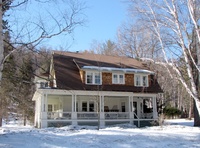 Roberts Cottage, c.1917 Roberts Cottage, c.1917 |
160 Park Avenue | 383 Park Avenue | A two-story, three bay, wood frame, Dutch Colonial Revival style residence built before 1917, it was the home of Dr. Carl Merkel, a noted T.B. surgeon. The building is clad in aluminum siding and covered by an asphalt-shingled gambrel roof punctuated by shed-roof dormers. The dwelling features an overhanging full-facade first story porch with paired Doric columns, rectangular balustrade, exposed rafter ends, paired sash windows in both one-over-one and two-over-two configurations, and bay windows on the first story porch. |
 McClellan/Wicker Cottage, 1898-1904 McClellan/Wicker Cottage, 1898-1904 |
166 Park Avenue | 391 Park Avenue |
A two and one-half story, five by three bay, wood frame, Colonial Revival style residence with Craftsman style details is clad in narrow wood siding and covered by an asphalt shingled hipped roof. Built between 1898 and 1904, the building features a central chimney; dormers; central entrance portico with pedimented gable roof, flat entablature, square Doric columns; Dutch doors at front of house as well as side porch; grouped multiple-paned sash windows, predominately two-over-two; and a two-story cure porch on southwestern end of the house, glazed with sliding glass panels on the second floor and screened on the first story. A second-story sleeping porch on the north side was added circa 1918. A veranda on the south side has been enclosed and long open front steps removed. |
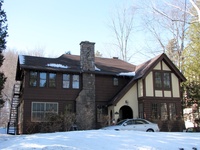 Fletcher Cottage, c.1925 Fletcher Cottage, c.1925 |
168 Park Avenue | 399 Park Avenue | Asymmetrically massed, two-story, wood frame, Tudor Revival style residence is clad with wood shingles and half-timbered stucco walls and covered by an asphalt-shingled, cross gable roof. The building, designed by William G. Distin and erected in ca.1925, features an arched entrance portico, prominent native stone chimney, asymmetrically grouped multiple-paned casement windows, a full porch on first story and sleeping porch with two entrances on second floor. Interior details include hand-operated two-person elevator, complete call bell system, wrought iron fire escape to south lawn, original wall-mounted light fixtures in the living and dining rooms, and almost all original plumbing and bath fixtures. |
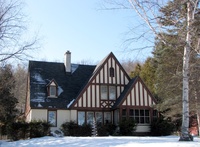 Frost House, c.1923 Frost House, c.1923 |
170 Park Avenue | 409 Park Avenue |
A two-story, wood frame, Tudor Revival style residence, with half-timbered stucco walls, steeply pitched asphalt-shingled gable roof, asymmetrically placed cross gable, a first story cure porch, rear sunporch, and grouped casement windows, most often six-over-one. A. contributing garage is also located on the property. |
See also
From the National Register of Historic Places Registration Form for the Highland Park Historic District
Highland Park Historic District is architecturally significant as an intact early twentieth century residential neighborhood designed and constructed as an upper-income enclave of single family homes, with cure related features. It was the largest and best-known of the three upper-class neighborhoods that were eventually built in the village. Among its residents were well-known local doctors, village trustees, and a number of millionaires who came to the area in search of a cure for tuberculosis, either for themselves or for a family member.
The land was originally the center of Ensine Miller's hop farm which extended for more than eighty acres across the tableland on the side of Mount Pisgah. Old Military Road, which crosses the property, is part of the route of the old Northwest Bay Road from Westport to Hopkinton. Miller had purchased the land in 1858 from the abolitionist Gerrit Smith, and he farmed it until his death in 1877. Orlando Blood obtained ownership of the parcel two years later, selling it to Dr. Edward L. Trudeau for use for his sanitarium in 1891. Not needing the additional space, Trudeau sold the property in 1894 to Dr. Ezra S. McClellan, who had moved to the area for the health of his daughter Daisietta.
The open, undeveloped land with its spectacular views and good location soon became a valuable commodity as Saranac Lake boomed in the decades around the turn of the century. McClellan began to develop the area by 1898, with the following deed restrictions:
-No building shall be erected nearer than forty feet of the street line.
-No building shall be erected that shall cost less than $2500. [about $70,000 in 2019]
-That the property sold shall be used only for residential purposes. [Minutes of the Meeting of the Board of Trustees, Village of Saranac Lake, December 22, 1906]
Lot sizes within the development were generally large, and the minimum construction cost was high for the time. The most unusual feature of the neighborhood was its specific exclusion of commercial enterprises, designed by McClellan to keep out private commercial cure cottages such as those already beginning to fill Helen Hill.
Frederick Seaver, a historian describing the village in 1918, made special mention of the rapid growth and exclusive nature of Highland Park:
Park Avenue in particular is as a whole the handsomest street that I know of anywhere in a place of this size. It has been built up in the main by those who have located here either in pursuit of health for themselves or for some member of the family. Land along it which sold a few years ago at a hundred dollars an acre now commands from three thousand dollars to ten thousand dollars per building lot, some of which have only a hundred feet frontage; and realty valuations generally of two generations ago were less than the charge now often made and willingly paid for a single quarter's rental of a large and well furnished cottage. One such property was recently taken from a reluctant lessor at four hundred dollars per month, and rentals for property smaller in size or less desirably located at one hundred and fifty to two hundred and fifty dollars are not uncommon. Historical Sketches of Franklin County, 1918, p. 384]
Dr. McClellan sold the first lot out of his original parcel, 143 Park Avenue, in 1898 to George V. W. Duryee, a broker from New York City who came to Saranac Lake for his health in 1892. Duryee established an extremely successful real estate business in Saranac Lake. Duryee also served the local community as Village Trustee, a member of the School Board, and the first, president of the Saranac Lake Free Library. Another early resident was Dr. Lawrason Brown, medical director at the Trudeau Sanatorium, who built his house at 142 Park Avenue in 1902. It was under Brown's supervision that the outdoor sleeping porch was developed and refined, and his own personal cure porch embodies such developments. Thomas B. Aldrich, prolific author and talented editor of the Atlantic Monthly, moved to Saranac Lake in 1901 with his tubercular son Charles, building 147 Park Avenue the following year to house the whole family. By 1910, more than half of the buildings within the district had been constructed. After Dr. McClellan died in December 1911, his daughters continued to sell the last few parcels of land within the district through the 1920s.
The Highland Park Historic District derives significance in the area of architecture as an intact collection of late nineteenth and early twentieth century, private, single family, cure cottage architecture. Cure cottages are structures that were commercial, residential or institutional in scale and expression. Many were built specifically to function as private commercial sanatoria, multiple unit dwellings, boarding houses, or private homes. Equally large numbers of cure cottages were adapted for that use from vernacular single family dwellings. All cure cottages display certain architectural features that were necessary for specific functions in the process of curing tuberculosis outdoors. Whether added at a later date or incorporated into the original building design, these features can include multiple-storied cure porches, sliding glass panels, call bells and wider-than-usual doorways without sills.
Many of the residences within the district were designed by local architects who incorporated characteristic curing features with representative examples of domestic architectural expressions popular in the late nineteenth and early twentieth centuries.
The district contains several fine examples of Shingle style residential architecture. The Duryee Cottage, 143 Park Avenue (1898), the Thomas B. Aldrich house, 147 Park Avenue (1902), and the Jordan Cottage, 138 Park Avenue (1905), all display typical characteristics of that style such as gambrel roofs, wood shingle siding, simple detailing, and horizontal bands of grouped windows.
The district contains numerous examples of popular revival styles, including four Tudor Revival style residences. The Nichols Cottage, 127 Park Avenue (1900) and its carriage house (1907), the Brown/Packard house, 142 Park Avenue (1902), and the later houses at 168 Park Avenue (ca.1923) and 170 Park Avenue (c. 1924) all include asymmetrical massing, multiple roof gables, grouped fenestration with multiple paned sash (including diamond-shaped panes in the two earlier structures), prominent chimneys, stone foundations, and decorative half-timbering.
Several outstanding examples of the Colonial Revival style architecture are located within the district. These dwellings feature symmetrical facades, regular fenestration, hipped roofs, and classically detailed entrance portico, dormers, and porches. Examples include the McClellan/Wicker house, 166 Park Avenue (ca.1900), the Henderson house at 154 Park Avenue (1907), and the Christy Mathewson house, 21 Old Military Road (1924). The Talbot Aldrich/Watson cottage at 153 Park Avenue (ca.1903) displays similar features in a more compact "American Foursquare" version. The gambrel-roofed Roberts/Worthen house, 160 Park Avenue (1917), is an unusually fine example of the Dutch Colonial Revival style.
Craftsman stylistic influences can be seen in the wide eaves and exposed rafter tails of the Todd/Carl Palmer Cottage, 157 Park Avenue (1906), but the original stucco facade was covered with cedar shingles in a series of alterations and additions during the 1920s-30s. More Teutonic design influences can be seen in the clipped jerkin-head gable of 134 Park Avenue (1930), and on the Wilson Cottage, 146 Park Avenue (1904), which is said to be modeled after a tuberculosis sanitarium chalet in Davos, Switzerland, where the wife of the first owner attempted a cure before moving to Saranac lake.
A rare local example of Mediterranean Revival style architecture stands at 135 Park Avenue, known variously as the Charles Palmer house or the Pink Palace. The result of extensive additions and remodeling in 1927, the building has smooth stucco walls, tinted pink, a classical rooftop balustrade and an arched entrance porch with broad, overhanging eaves.
No new buildings were constructed in the Highland Park Historic District after 1930, and none of the early buildings have been removed. Most of the buildings retain their original curing features and architectural detail. The district also retains a strikingly high degree of integrity of setting, location, materials, and design.
From the Adirondack Daily Enterprise, March 18, 1983
Highland Park-Spanning decades of gracious living
By PHIL GALLOS
SARANAC Lake - Highland Park, defined as Old Military Road and Park Avenue from their intersection to their termini at the American Management Association's gates, is Saranac Lake's classic example of a planned, residential neighborhood. Highland Park is a showcase of beautiful houses. The Nichols House at 127 Park Avenue is one of the oldest and most distinctive of these.
Highland Park was an unpopulated tableland between Mount Pisgah and the Saranac River when Dr. Ezra S. McClellan built a house at what is now 22 Old Military Road. The year was 1890. Dr. McClellan had moved to the area with his daughter Elizabeth with the hope that she could regain her health. He bought all of the vacant tableland, which soon became known as McClellan's Hill.
Sometime prior to 1898, Dr. McClellan built the charming pole-log house at 16 Old Military Road as a studio and occasional residence for his other daughter, Katherine, who was a professional photographer.
She had graduated from Smith College in 1892, became the official photographer for Smith, and established a flourishing studio with her permanent residence near the Smith campus in Northhampton, Massachusetts. She was active enough in her Saranac Lake studio, as well, to document early Winter Carnival activities and produce two photo-illustrated, promotional booklets of the Keene Valley area.
Dr. McClellan now had a very large parcel of land with two houses at one corner of it. The Adirondack Cottage Sanatorium had been established by Dr. E.L. Trudeau in 1884 on land adjoining Dr. McClellan's to the north.
The year Katherine graduated from Smith, Saranac Lake village became an incorporated municipality. Dr. McClellan's land was within the corporation limits; the sanatorium was not. Furthermore, this property was perhaps the largest, level, unpopulated area in the village, yet its elevation allowed splendid views of Mount Baker and the High Peaks. The development potential for McClellan's Hill was self-evident, and so Highland Park was born.
Highland Park was conceived as an upper-income, "restricted," residential neighborhood. It was not ethnically restricted as were many, if not most, upper-income communities in the United States in those times. The restriction applied to the private sanatoria that were springing up along the rest of Park Avenue, on Helen Hill, and elsewhere in the village. There was no ban against tubercular individuals living in Highland Park, but those individuals had to be living in single-family homes. Thus, though there are plenty of cure porches visible in Highland Park, there is not a single "cure cottage."
Dr. McClellan died in 1912. By then he had not only founded a unique neighborhood, but he had also won respect and gratitude for his unflagging dedication as Saranac Lake's first public health officer.
Continued at Highland Manor
Source:
See also



